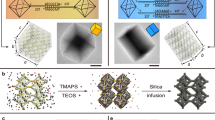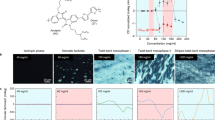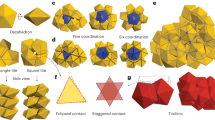Abstract
Establishing precise control over the shape and the interactions of the microscopic building blocks is essential for design of macroscopic soft materials with novel structural, optical and mechanical properties. Here, we demonstrate robust assembly of DNA origami filaments into cholesteric liquid crystals, one-dimensional supramolecular twisted ribbons and two-dimensional colloidal membranes. The exquisite control afforded by the DNA origami technology establishes a quantitative relationship between the microscopic filament structure and the macroscopic cholesteric pitch. Furthermore, it also enables robust assembly of one-dimensional twisted ribbons, which behave as effective supramolecular polymers whose structure and elastic properties can be precisely tuned by controlling the geometry of the elemental building blocks. Our results demonstrate the potential synergy between DNA origami technology and colloidal science, in which the former allows for rapid and robust synthesis of complex particles, and the latter can be used to assemble such particles into bulk materials.
This is a preview of subscription content, access via your institution
Access options
Access Nature and 54 other Nature Portfolio journals
Get Nature+, our best-value online-access subscription
$29.99 / 30 days
cancel any time
Subscribe to this journal
Receive 12 print issues and online access
$259.00 per year
only $21.58 per issue
Buy this article
- Purchase on Springer Link
- Instant access to full article PDF
Prices may be subject to local taxes which are calculated during checkout






Similar content being viewed by others
References
Pusey, P. N. & Van Megen, W. Phase-behavior of concentrated suspension of nearly hard colloidal spheres. Nature 320, 340–342 (1986).
Onsager, L. The effects of shape on the interaction of colloidal particles. Ann. New York Acad. Sci. 51, 627–659 (1949).
Damasceno, P. F., Engel, M. & Glotzer, S. C. Predictive self-assembly of polyhedra into complex structures. Science 337, 453–457 (2012).
Wang, Y. et al. Colloids with valence and specific directional bonding. Nature 491, 51–55 (2012).
Henzie, J., Grünwald, M., Widmer-Cooper, A., Geissler, P. L. & Yang, P. Self-assembly of uniform polyhedral silver nanocrystals into densest packings and exotic superlattices. Nat. Mater. 11, 131–137 (2012).
Glotzer, S. C. & Solomon, M. J. Anisotropy of building blocks and their assembly into complex structures. Nat. Mater. 6, 557–562 (2007).
Nykypanchuk, D., Maye, M. M., van der Lelie, D. & Gang, O. DNA-guided crystallization of colloidal nanoparticles. Nature 451, 549–552 (2008).
Mundoor, H., Senyuk, B. & Smalyukh, I. I. Triclinic nematic colloidal crystals from competing elastic and electrostatic interactions. Science 352, 69–73 (2016).
Muševič, I., Škarabot, M., Tkalec, U., Ravnik, M. & Žumer, S. Two-dimensional nematic colloidal crystals self-assembled by topological defects. Science 313, 954–958 (2006).
Dietz, H., Douglas, S. M. & Shih, W. M. Folding DNA into twisted and curved nanoscale shapes. Science 325, 725–730 (2009).
Douglas, S. M. et al. Self-assembly of DNA into nanoscale three-dimensional shapes. Nature 459, 414–418 (2009).
Bai, X. C., Martin, T. G., Scheres, S. H. W. & Dietz, H. Cryo-EM structure of a 3D DNA-origami object. Proc. Natl Acad. Sci. USA 109, 20012–20017 (2012).
Gerling, T., Wagenbauer, K. F., Neuner, A. M. & Dietz, H. Dynamic DNA devices and assemblies formed by shape-complementary, non-base pairing 3D components. Science 347, 1446–1452 (2015).
Lu, F., Yager, K. G., Zhang, Y. G., Xin, H. L. & Gang, O. Superlattices assembled through shape-induced directional binding. Nat. Commun. 6, 6912 (2015).
Barry, E. & Dogic, Z. Entropy driven self-assembly of nonamphiphilic colloidal membranes. Proc. Natl Acad. Sci. USA 107, 10348–10353 (2010).
Gibaud, T. et al. Reconfigurable self-assembly through chiral control of interfacial tension. Nature 481, 348–351 (2012).
Sharma, P., Ward, A., Gibaud, T., Hagan, M. F. & Dogic, Z. Hierarchical organization of chiral rafts in colloidal membranes. Nature 513, 77–80 (2014).
Pfitzner, E. et al. Rigid DNA beams for high-resolution single-molecule mechanics. Angew. Chem. Int. Ed. 52, 7766–7771 (2013).
Tortora, L. & Lavrentovich, O. D. Chiral symmetry breaking by spatial confinement in tactoidal droplets of lyotropic chromonic liquid crystals. Proc. Natl Acad. Sci. USA 108, 5163–5168 (2011).
Douglas, S. M., Chou, J. J. & Shih, W. M. DNA-nanotube-induced alignment of membrane proteins for NMR structure determination. Proc. Natl Acad. Sci. USA 104, 6644–6648 (2007).
Dogic, Z. & Fraden, S. Cholesteric phase in virus suspensions. Langmuir 16, 7820–7824 (2000).
Grelet, E. & Fraden, S. What is the origin of chirality in the cholesteric phase of virus suspensions? Phys. Rev. Lett. 90, 198302 (2003).
Purdy, K. R. et al. Measuring the nematic order of suspensions of colloidal fd virus by X-ray diffraction and optical birefringence. Phys. Rev. E 67, 031708 (2003).
Dogic, Z. & Fraden, S. Development of model colloidal liquid crystals and the kinetics of the isotropic-smectic transition. Phil. Trans. R. Soc. A 359, 997–1014 (2001).
Purdy, K. R. & Fraden, S. Isotropic-cholesteric phase transition of filamentous virus suspensions as a function of rod length and charge. Phys. Rev. E 70, 061703 (2004).
Tang, J. X. & Fraden, S. Isotropic-cholesteric phase-transition in colloidal suspension of filamentous bacteriophage-fd. Liq. Cryst. 19, 459–467 (1995).
Harris, A. B., Kamien, R. D. & Lubensky, T. C. Microscopic origin of cholesteric pitch. Phys. Rev. Lett. 78, 2867–2867 (1997).
Oda, R., Huc, I., Schmutz, M., Candau, S. & MacKintosh, F. Tuning bilayer twist using chiral counterions. Nature 399, 566–569 (1999).
Zanchetta, G. et al. Right-handed double-helix ultrashort DNA yields chiral nematic phases with both right-and left-handed director twist. Proc. Natl Acad. Sci. USA 107, 17497–17502 (2010).
Cao, J., Liu, S., Xiong, J., Chen, Y. & Zhang, Z. Stimuli responsive chiral liquid crystal phases of phenylboronic acid functionalized rodlike viruses and their interaction with biologically important diols. Chem. Commun. 50, 10402–10405 (2014).
Růžička, Š. & Wensink, H. H. Simulating the pitch sensitivity of twisted nematics of patchy rods. Soft Matter 12, 5205–5213 (2016).
Dussi, S. & Dijkstra, M. Entropy-driven formation of chiral nematic phases by computer simulations. Nat. Commun. 7, 11175 (2016).
Castro, C. E. et al. A primer to scaffolded DNA origami. Nat. Methods 8, 221–229 (2011).
Barry, E., Beller, D. & Dogic, Z. A model liquid crystalline system based on rodlike viruses with variable chirality and persistence length. Soft Matter 5, 2563–2570 (2009).
Asakura, S. & Oosawa, F. Interaction between particles suspended in solutions of macromolecules. J. Polym. Sci. 33, 183–192 (1958).
Dalhaimer, P., Bates, F. S. & Discher, D. E. Single molecule visualization of stable, stiffness-tunable, flow-conforming worm micelles. Macromolecules 36, 6873–6877 (2003).
Ziserman, L., Mor, A., Harries, D. & Danino, D. Curvature instability in a chiral amphiphile self-assembly. Phys. Rev. Lett. 106, 238105 (2011).
Gittes, F., Mickey, B., Nettleton, J. & Howard, J. Flexural rigidiy of microtubules and actin-filaments measured from therma fluctuation in shape. J. Cell Biol. 120, 923–934 (1993).
Smith, S. B., Finzi, L. & Bustamante, C. Direct mechanical measurements of the elasticity of single DNA-molecules by using magnetic beads. Science 258, 1122–1126 (1992).
Yang, Y. S., Barry, E., Dogic, Z. & Hagan, M. F. Self-assembly of 2D membranes from mixtures of hard rods and depleting polymers. Soft Matter 8, 707–714 (2012).
Kaplan, C. N., Tu, H., Pelcovits, R. A. & Meyer, R. B. Theory of depletion-induced phase transition from chiral smectic-A twisted ribbons to semi-infinite flat membranes. Phys. Rev. E 82, 021701 (2010).
Kang, L., Gibaud, T., Dogic, Z. & Lubensky, T. Entropic forces stabilize diverse emergent structures in colloidal membranes. Soft Matter 12, 386–401 (2016).
Nakata, M. et al. End-to-end stacking and liquid crystal condensation of 6- to 20-base pair DNA duplexes. Science 318, 1276–1279 (2007).
Park, C-Y., Fygenson, D. K. & Saleh, O. A. Electrostatics and depletion determine competition between 2D nematic and 3D bundled phases of rod-like DNA nanotubes. Soft Matter 12, 5089–5095 (2016).
Frenkel, D. Entropy-driven phase transitions. Physica A 263, 26–38 (1999).
Rambaran, R. N. & Serpell, L. C. Amyloid fibrils Abnormal protein assembly. Prion 2, 112–117 (2008).
Knowles, T. P. et al. Role of intermolecular forces in defining material properties of protein nanofibrils. Science 318, 1900–1903 (2007).
Zhou, Y. et al. Biomimetic hierarchical assembly of helical supraparticles from chiral nanoparticles. ACS Nano 10, 3248–3256 (2016).
Won, Y. Y., Davis, H. T. & Bates, F. S. Giant wormlike rubber micelles. Science 283, 960–963 (1999).
Kuzyk, A. et al. DNA-based self-assembly of chiral plasmonic nanostructures with tailored optical response. Nature 483, 311–314 (2012).
Rothemund, P. W. K. Folding DNA to create nanoscale shapes and patterns. Nature 440, 297–302 (2006).
Stahl, E., Martin, T. G., Praetorius, F. & Dietz, H. Facile and scalable preparation of pure and dense DNA origami solutions. Angew. Chem. Int. Ed. Engl. 53, 12735–12740 (2014).
Kick, B., Praetorius, F., Dietz, H. & Weuster-Botz, D. Efficient production of single-stranded phage DNA as scaffolds for DNA origami. Nano Lett. 15, 4672–4676 (2015).
Douglas, S. M. et al. Rapid prototyping of 3D DNA-origami shapes with caDNAno. Nucleic Acids Res. 37, 5001–5006 (2009).
Lau, A. W. C., Prasad, A. & Dogic, Z. Condensation of isolated semi-flexible filaments driven by depletion interactions. Europhys. Lett. 87, 48006 (2009).
Brangwynne, C. P. et al. Bending dynamics of fluctuating biopolymers probed by automated high-resolution filament tracking. Biophys. J. 93, 346–359 (2007).
Maniatis, T., Sambrook, J. & Fritsch, E. Molecular CloningCh 3 (Cold Spring Harbor Laboratory, 1989).
Lettinga, M. P., Barry, E. & Dogic, Z. Self-diffusion of rod-like viruses in the nematic phase. Europhys. Lett. 71, 692–698 (2005).
Oldenbourg, R. Polarized light field microscopy: an analytical method using a microlens array to simultaneously capture both conoscopic and orthoscopic views of birefringent objects. J. Microsc. 231, 419–432 (2008).
Barry, E., Hensel, Z., Dogic, Z., Shribak, M. & Oldenbourg, R. Entropy-driven formation of a chiral liquid-crystalline phase of helical filaments. Phys. Rev. Lett. 96, 018305 (2006).
Acknowledgements
We acknowledge support of NSF-MRSEC-1420382 and NSF-DMR-1609742 (to M.S., M.J.Z. and Z.D). We also acknowledge use of the Brandeis MRSEC optical microscopy and biosynthesis facility supported by NSF-MRSEC-1420382, as well as a Hans Fisher Senior Fellowship from TUM Institute of Advanced Study. This work was also supported by a European Research Council Starting Grant to H.D. (GA no. 256270) and by the Deutsche Forschungsgemeinschaft through grants provided via the TUM Institute of Advanced Study, the Cluster of Integrated Protein Science, the Nano Initiative Munich, and the Gottfried-Wilhelm-Leibniz Program (C.H.W., F.P. and H.D.).
Author information
Authors and Affiliations
Contributions
H.D. and Z.D. conceived the experiments. M.S. and M.J.Z. performed initial experimental observations. M.S. performed all the experiments. C.H.W. designed and characterized origami filaments. Z.D., M.S., H.D., C.H.W. and M.J.Z. analysed the experimental data. F.P. developed methods to purify large quantities of scaffold and provided them for our studies. M.S., H.D. and Z.D. wrote the manuscript. All authors revised the manuscript.
Corresponding authors
Ethics declarations
Competing interests
The authors declare no competing financial interests.
Supplementary information
Supplementary Information
Supplementary Information (PDF 243 kb)
Supplementary Movie 1
Supplementary Movie 1 (AVI 3374 kb)
Supplementary Movie 2
Supplementary Movie 2 (AVI 1584 kb)
Supplementary Movie 3
Supplementary Movie 3 (AVI 3340 kb)
Supplementary Movie 4
Supplementary Movie 4 (AVI 7060 kb)
Supplementary Movie 5
Supplementary Movie 5 (AVI 611 kb)
Supplementary Movie 6
Supplementary Movie 6 (AVI 715 kb)
Supplementary Movie 7
Supplementary Movie 7 (AVI 1207 kb)
Supplementary Movie 8
Supplementary Movie 8 (AVI 6881 kb)
Rights and permissions
About this article
Cite this article
Siavashpouri, M., Wachauf, C., Zakhary, M. et al. Molecular engineering of chiral colloidal liquid crystals using DNA origami. Nature Mater 16, 849–856 (2017). https://doi.org/10.1038/nmat4909
Received:
Accepted:
Published:
Issue Date:
DOI: https://doi.org/10.1038/nmat4909
This article is cited by
-
Disentangling kinetics from thermodynamics in heterogeneous colloidal systems
Nature Communications (2023)
-
Chiral self-assembly of cellulose nanocrystals is driven by crystallite bundles
Nature Communications (2022)
-
Self-assembled inorganic chiral superstructures
Nature Reviews Chemistry (2022)
-
Ultrastable liquid crystalline blue phase from molecular synergistic self-assembly
Nature Communications (2021)
-
Meta-DNA structures
Nature Chemistry (2020)



